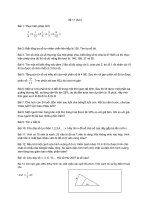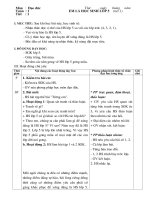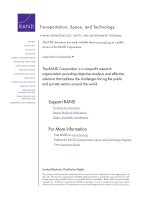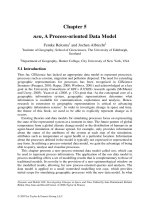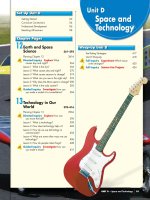- Trang chủ >>
- Mầm non - Tiểu học >>
- Lớp 5
5 5 2 inventions from space travel (space and technology) TG
Bạn đang xem bản rút gọn của tài liệu. Xem và tải ngay bản đầy đủ của tài liệu tại đây (121.8 KB, 4 trang )
Inventions
from Space Travel
SUMMARY
Many modern-day inventions initially
developed for space travel have led to new
products and tools that we use in everyday life.
LESSON VOCABULARY
absorb
impacts
perilous
shuttle
friction
insulation
relics
transmitter
INTRODUCE THE BOOK
INTRODUCE THE TITLE AND AUTHOR
Discuss with
students the title and the author of Inventions
from Space Travel. Based on the title, ask
students to say what they think the book will
be about.
BUILD BACKGROUND
Discuss what students
know about the kinds of technology that are
used in space. Ask them to think about the
needs of astronauts in space. Invite them to
share their thoughts about the difficulties
of living in a space station.
PREVIEW/USE TEXT FEATURES
As students preview the book, the photos will probably attract
their attention. Suggest that students also
notice captions and heads. Point out the list
on page 23.
READ THE BOOK
SET PURPOSE
Have students set a purpose for
reading Inventions from Space Travel. Students’
interest in space exploration should guide this
purpose. Suggest that students think about
the most modern kinds of technology that
astronauts might need on extended space
flights. Or invite them to think of common
modern household appliances. Ask: Which
ones do you think might have been developed
from space technology?
96
5.5.2
MAIN IDEA
ASK QUESTIONS
STRATEGY SUPPORT: ASK QUESTIONS
As students
read selection, suggest they make a list of
questions, leaving a space by each. When
they finish the book, invite them to decide
what kind of questions they have generated.
Suggest they label each question with one
of the following: Before Reading Questions,
During Reading Questions, After Reading
Questions. Students may want to take one of
their questions as a jumping-off point for a
future writing assignment.
COMPREHENSION QUESTIONS
PAGE 4
What tool did NASA invent to help
astronauts get samples from below the
moon’s surface? (cordless drill)
PAGE 7
What was the first major sporting
event to be shown live around the world?
(1964 Olympic Games in Tokyo, Japan)
PAGE 12 How have firefighters benefited from
the space program? (Their breathing system
is based on the system that astronauts used
on the moon.)
PAGE 14
What did the Federal Aviation
Administration and NASA work together to
develop? (a warning system to predict wind
shear used by all airlines today)
PAGE 18
What did NASA create for the National
Archives? (an imaging device to tell the state of
very old documents)
PAGE 21
What technology has NASA developed
to help clean up oil spills? (balls of beeswax
that absorb oil but not water)
Inventions from Space Travel
16924_LRD_TG_096-097 96
11/17/05 8:35:41 AM
REVISIT THE BOOK
READER RESPONSE
1. Responses will vary.
2. Students should think of two or more questions about space inventions used in sports.
3. Paragraphs will vary but should show students’ understanding of glossary words.
4. Responses will vary.
EXTEND UNDERSTANDING
As students look at
the photo on page 16, ask how they think
doctors use digital imaging to help patients.
Ask if they have seen digital images from
space. Have them talk about other ways digital
imaging might be used.
RESPONSE OPTIONS
WRITING
Suggest that students write two
paragraphs about how inventions developed
for space exploration have been adapted to
daily life on Earth.
SCIENCE CONNECTION
Students can learn more about
digital imaging on the Internet
or at the library. Suggest they find
a digital image of their local area as seen
from space: They
might also want to take a look at NASA’s digital images of the solar system.
Skill Work
TEACH/REVIEW VOCABULARY
To reinforce the meaning of perilous, read
the first paragraph on page 10. Ask students to say what they think perilous means.
If they are not sure, have them look up the
word in a dictionary. Continue in a similar
fashion with the remaining vocabulary words.
TARGET SKILL AND STRATEGY
MAIN IDEA Remind students that the
main idea is the most important idea about
a topic. As students read through this book,
have them look for the main idea in each
section. Invite them to decide if the main
idea is stated or must be inferred. Suggest
they write a paragraph about what they
think is the main idea of each section.
ASK QUESTIONS Remind students that
to ask questions means to inquire about
important text information. Skilled readers
generate questions before, during, and after
reading. Remind students that asking questions as they read can help them identify the
main idea of each section. Have them write
“What is the main idea of this section?” on a
piece of paper and take notes as they read.
Have students dictate three
questions about the selection to other
students. Have them work together to find
the answers to the questions in the book.
Then have them present their questions
and answers in pairs.
ADDITIONAL SKILL INSTRUCTION
GENERALIZE
Remind students that a
generalization is a broad statement that
applies to many examples. It may be stated
positively, as in Many inventions from space
have been adapted for domestic use.
Or it may be stated negatively, as in No
astronauts have yet explored Jupiter on foot.
Encourage students to look for clue words
(most, many, none, never, etc.) as they try
to identify the author’s generalizations and
formulate their own.
Inventions from Space Travel
16924_LRD_TG_096-097 97
97
11/17/05 8:35:42 AM
Space Travel Inventions
Name
Main Idea
• The main idea is the most important idea about a topic.
• The author may state the main idea. Sometimes, however, readers must figure out the main idea
and point to details that support it.
Directions Identify the main idea and supporting details of Inventions from Space Travel. Fill in the
graphic organizer below to organize your information.
Main Idea
Supporting Details
Subhead:
© Pearson Education 5
Subhead:
98
16924_LRD_TG_098-099 1
11/17/05 8:36:05 AM
Space Travel Inventions
Name
Vocabulary
Directions Read each sentence. Write the word from the box that
has the same meaning as the underlined word or phrase.
Check the Words You Know
absorb
perilous
friction
relics
impacts
shuttle
insulation
transmitter
1. Special fabrics can reduce the force or rubbing that slows a body in motion, allowing runners
or other athletes to move more swiftly.
2. The astronaut used a device that sends out signals to keep in contact with her
fellow astronauts.
3. Foam rubber inside your helmet will take in the shock if you should fall and hit your head.
4. The space travelers took the vehicle that runs back and forth from Earth to the moon.
5. The sudden jarring of objects hitting each other caused the astronauts to bounce around inside
the space capsule.
6. The archaeologists found many objects from the past at their newest digging site.
© Pearson Education 5
7. Astronauts face a dangerous adventure each time they blast off.
8. In planning the new space craft, the scientists wanted the very best material for holding in heat
that they could find.
Directions Write a paragraph summary of Inventions from Space Travel. Use as many
vocabulary words as you can.
99
16924_LRD_TG_098-099 99
12/2/05 4:20:55 PM
